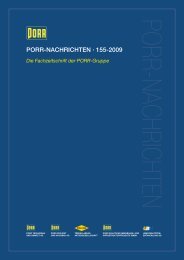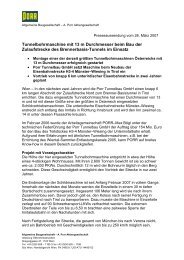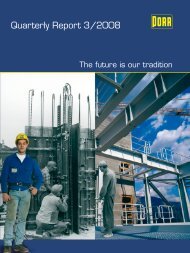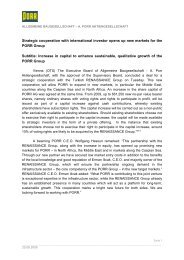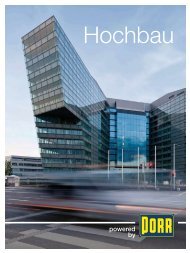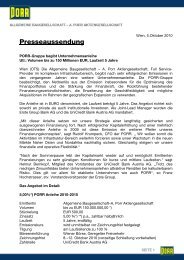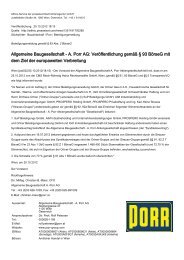Untitled - Porr
Untitled - Porr
Untitled - Porr
Create successful ePaper yourself
Turn your PDF publications into a flip-book with our unique Google optimized e-Paper software.
Foundation<br />
engineering
Milestones<br />
2008: SAVA BRIDGE<br />
The new cable-stayed bridge over the Sava is one<br />
of the most modern bridges of its type anywhere<br />
in the world. The 200 m-high pylon, span of 375 m<br />
and 45 m-wide deck presented an enormous technical<br />
challenge which PORR overcame with aplomb.<br />
On this project PORR's foundation engineering<br />
specialists employed a customised solution<br />
for the pylon foundations.<br />
1997: TIROLER ACHE BRIDGE<br />
For the deep foundations of Tiroler Ache bridge piles<br />
reaching maximum depths of 70 m were placed. For<br />
the first time, PORR used bentonite slurry as a supporting<br />
medium.<br />
1992: FREUDENAU DANUBE POWER<br />
PLANT<br />
The foundation engineering department of<br />
the PORR Group implemented all specialist<br />
foundation construction operations (diaphragm<br />
walls, sheet piles, anchors, vibrated<br />
VIB-walls). Up to 5 diaphragm wall units<br />
have been in permanent operation.<br />
1934: EXPRESS PILES IN PALESTINE<br />
The pile foundation method for buildings<br />
developed by PORR turned out to be highly<br />
successful throughout the 1920's and<br />
1930's. It was widely employed for international<br />
projects. The photo taken in the<br />
summer of 1934 shows foundation works in<br />
the concrete plant Nesher in Haifa, Palestine<br />
with roughly 400 express piles.<br />
1904: EXPRESS PILES<br />
Parallel to the development of cast-in-place concrete piles<br />
in the USA, Ottokar Stern from PORR devised a method<br />
of his own: foundations on „floating piles“. In 1904<br />
this method was first applied in Vienna. In 1911 the Imperial<br />
and Royal Patent Office issued the patent certificate.<br />
2<br />
2011<br />
2004<br />
1994<br />
1974<br />
1927<br />
1869<br />
2008<br />
1997<br />
1992<br />
1934<br />
1904<br />
2011: DC TOWER 1<br />
At a height of 220 m, the DC Tower 1 will<br />
be Austria's tallest building upon completion.<br />
PORR foundation engineering was<br />
responsible for the comprehensive pit and<br />
foundation works on this technically challenging,<br />
large-scale project and was once<br />
again able to display its expert skills.<br />
2004: RIVER WIEN COLLECTOR SEWERS<br />
PORR Group installed reinforced concrete<br />
diaphragm walls up to maximum depths of<br />
50 m for the Wiental-Kanal (River Wien Valley<br />
Sewer).<br />
1994: DEEPEST DIAPHRAGM WALL IN EUROPE<br />
The foundation engineering department of the PORR<br />
Group constructed the deepest diaphragm walls in<br />
Europe with the grab method. They are situated at the<br />
intersection Schüttdorf/Zell am See with maximum<br />
depths of 104 m.<br />
1974: U1 STEPHANSPLATZ<br />
The construction of the Vienna Underground started<br />
in 1969 and gave major impact to the construction<br />
sector. PORR AG participated in a leading position<br />
in some sections, i.e. from Stephansplatz to Nestroyplatz<br />
of line U1. The picture (taken in 1974) shows<br />
the open pit with back-anchored bored pile walls<br />
of line U1, Stephansplatz.<br />
1927: FOUNDATION PILES KARL MARX<br />
HOF<br />
One example of the many pile foundation<br />
works which PORR has carried out on<br />
Viennese council buildings is the Karl Marx<br />
Hof in Vienna's 19th district, where around<br />
8,000 piles were driven with 12 newly built,<br />
cutting-edge machines, known as „Grundkörpermaschinen“.<br />
1869: FOUNDATION OF „ALLGEMEINE ÖSTER-<br />
REICHISCHE BAUGESELLSCHAFT“<br />
First listing on the stock exchange. In 1927 the<br />
company merges with A. <strong>Porr</strong> Betonbauunternehmung<br />
GmbH.
Foreword<br />
The foundation engineering department of the PORR Group<br />
is active in all services of special foundation engineering in<br />
Austria, Germany and in Central and Eastern Europe.<br />
Numerous services are offered: „heavy machinery“ technologies<br />
such as vibrated VIB-walls reaching maximum depths of<br />
30 m, sheet piling up to a depth of 26 m, diaphragm walls and<br />
bore piles as well as „light“ special foundation engineering<br />
operations such as micro piles, anchors, jet grouting, injections<br />
and pile driving.<br />
The construction of the deepest diaphragm walls in Europe<br />
with a depth of 104 m (Zell am See) and the 70 m deep foundations<br />
of Tiroler Ache bridge (Chiemsee) with large-diameter<br />
bore piles are two examples that demonstrate PORR's state<br />
of art engineering performance.<br />
In addition to the PORR headquarter in Vienna, there are local<br />
branches in Linz, Munich, Budapest and Bucharest.<br />
This folder is addressed to all clients, experts and friends of<br />
PORR and provides an overview of procedures and solutions<br />
in special foundation engineering situations. Our experienced<br />
team is at your service not only for the realisation of projects<br />
but also for the design of optimized alternative solutions.<br />
Brochure of the year 1953<br />
Working programme<br />
1 | Diaphragm walls 4-5<br />
Cast-in-place diaphragm walls and sealing walls<br />
(40 to 150 cm thickness), in grab or cutter method<br />
2 | Bored piles 6-7<br />
Cased with diameters ranging from 60 to 150 cm and<br />
in CFA method for diameters from 40 to 120 cm<br />
3 | Sheet pile walls 8-9<br />
For pit stabilisation and water construction projects<br />
(maximum depths 26 m)<br />
4 | VIB-walls 10-11<br />
For sealing walls (maximum depths 30 m)<br />
5 | Soil mixing system 12-13<br />
As sealing and deep foundation elements<br />
and for pit stabilisation<br />
6 | Anchors 14-15<br />
Pre-stressed temporary or permanent anchors<br />
(strand or bar anchors) up to 1,500 kN and a<br />
length of more than 100 m<br />
7 | Jet grouting 16-17<br />
For deep foundations and / or underpinnings<br />
of planned or existing buildings<br />
8 | Micro piles 18-19<br />
Deep foundation elements with individual bearing<br />
capacities of up to 1,500 kN<br />
9 | Soil nail walls 20-21<br />
Back-anchored shotcrete shells for excavation<br />
and for slope stabilisation<br />
10 | Injections 22-23<br />
For compaction, sealing and uplifiting purposes<br />
11 | Design 24-25<br />
Structural design for detailed pit solutions<br />
12 | Quality assurance 26-27<br />
Research and development of testing methods<br />
13 | Health & Safety 30-31<br />
Occupational safety and promoting good health<br />
3
4<br />
Inserting diaphragm wall reinforcement, U2-1 Schottenring, Vienna<br />
1 | Diaphragm walls<br />
1<br />
2<br />
Diaphragm walls are applied for deep excavations and<br />
as deep foundation elements with a statical function. Diaphragm<br />
walls are used for landfills, for flood control projects<br />
and for the construction of sealing walls (cut-off walls).<br />
3<br />
4<br />
Technical Data<br />
Thickness of<br />
diaphragm wall<br />
Depths of<br />
diaphragm walls<br />
40, 50, 60, 80, 100,<br />
120 und 150 cm<br />
up to 100 m<br />
Grab openings 2.80 m, 3.60 m, 4.20 m<br />
Cutting width 2.80 m<br />
Equipment Cable dredger up to<br />
120 tonnes
Construction<br />
Grab method<br />
Construction of guide walls to support the<br />
uppermost ground portions and to guide the<br />
grab<br />
Excavation of trench elements with a cableoperated<br />
grab (8 to 22 tonnes)<br />
Securing of diaphragm walling with stabilising<br />
slurry (bentonite suspension)<br />
Installation of joint systems or pre-cast elements<br />
as well as installation of reinforcement cage after<br />
the planned wall depth has been reached<br />
Placing of concrete in tremie method.<br />
Simultaneously, the suspension is pumped out<br />
Cutter method<br />
� Construction of guide walls higher the secure<br />
the uppermost ground portions and to guide the<br />
grab<br />
� Reaching of design depth with a grab suspended<br />
hydro cutter<br />
� Creation of joints by interlocking of adjoining<br />
trench elements<br />
� Removal of the loosened material together with<br />
the stabilising slurry through delivery pipes to the<br />
seperation unit<br />
� Removal of the spoil<br />
� Further steps: see grab system<br />
Tests<br />
� Position, twisting and verticality of the trench<br />
(inclinometers, ultrasound measuring devices)<br />
Applications<br />
� Deep excavation pits with only small<br />
deformations, with or without anchors, watertight;<br />
mainly used in inner-city areas<br />
� Deep foundations of buildings or as urban<br />
elements<br />
Soil<br />
Rock<br />
Gravel<br />
Structural function<br />
Sand<br />
Very high<br />
Works on the diaphragm walls, DC Tower, Vienna<br />
Silt<br />
Clay<br />
0<br />
5<br />
10<br />
20<br />
50<br />
100 m<br />
Depth<br />
Sealing function<br />
0<br />
Very high<br />
■ optimal range of application<br />
0<br />
Very high<br />
Relative performance<br />
5
Reinforcing cage for an energy pile<br />
2 | Bored piles<br />
6<br />
1<br />
2<br />
3<br />
4<br />
5<br />
Bored piles with diameters from 40 – 150 cm<br />
are used as deep foundation elements and<br />
for pit stabilisation purposes. They can be<br />
constructed as individual piles, in group formation<br />
or as secant pile wall with a sealing<br />
function. The piles are fully cased, whereby<br />
either the grab or the rotary drilling<br />
system is employed. If the ground<br />
conditions permit it, the CFA piling<br />
method is applied.<br />
Technical Data<br />
Grab and rotary drill<br />
method<br />
Rotary drill method<br />
with continous flight<br />
auger<br />
Ø 60 to 150 cm<br />
Ø 40 to 120 cm<br />
Equipment Cable dredger up to 120<br />
tonnes, drilling rig up to<br />
100 tonnes
Construction<br />
Cased drilling<br />
Excavation with grab or auger secured by the<br />
well casing<br />
Installation of reinforcement cage<br />
Placement of pile concrete (tremie method)<br />
Removal of the well casing<br />
Drilling<br />
Stable soil conditions; excavation without well<br />
casing<br />
� If required, support of the trench wall with water<br />
or supporting fluid (bentonite)<br />
� Pressing of the concrete through auger pipe<br />
while extracting the auger<br />
� The reinforcement cage is vibrated or pressed<br />
into the ground<br />
Processes and variety of systems<br />
� Grab method with base carrier and hydraulic<br />
oscillator<br />
� Rotary drilling method and leader mounted<br />
drilling auger<br />
� CFA method with continous fight auger<br />
Tests<br />
� Non-destructive, dynamic pile testing to<br />
determine continuity of concrete column<br />
Applications<br />
� Deep foundations in the whole construction area<br />
� Pit stabilisation by means of a bored pile wall –<br />
with or without anchors – with spaced touching<br />
or secant bored piles<br />
� Drilling for interpile sheeting, Berlin or Munich<br />
Type (steel girders with wood-prefabricated or<br />
shotcrete arches)<br />
Soil<br />
Rock<br />
Gravel<br />
Structural function<br />
Sand<br />
Very high<br />
Silt<br />
Clay<br />
0<br />
5<br />
10<br />
20<br />
50<br />
100 m<br />
Depth<br />
Sealing function<br />
0<br />
Very high<br />
■ optimal range of application<br />
Bored pile works, Knapsack power plant, Cologne<br />
0<br />
Very high<br />
Relative performance<br />
7
8<br />
Oval island with sheet pile walls, ÖBB bridge, Krems<br />
3 | Sheet pile walls<br />
1<br />
2<br />
Sheet piling is used to stabilise level differences, to seal<br />
an area (against water or contaminated soils) and for pit<br />
stabilisation. They are also applied as structural elements<br />
in hydraulic engineering (quay walls, sewers, moles, port<br />
basins or in flood control). In combination with interlock<br />
sealing systems pile walls are nearly watertight.<br />
Technical Data<br />
Driving depth up to 26 m<br />
Sheet pile profiles Larssen PU12 to PU32,<br />
Hösch AZ12 to AZ46<br />
Interlock sealing with bitumen-based<br />
system<br />
interlock filler (technically<br />
tight)<br />
Pile drivers adjustable high-frequency<br />
vibrators to minimise<br />
vibrations<br />
Equipment leader rigs up to 100<br />
tonnes
Construction<br />
� In case of hard ground or firm soil support by<br />
jets of water at high pressure or pre-drilling with<br />
auger<br />
Driving of the sheet piles (if necessary insertion<br />
into the technically dense soil)<br />
Installation of walls by placing interlocked sheet<br />
piles next to each other<br />
Processes and variety of systems<br />
� Free riding cable-operated (crawler crane),<br />
partially guided systems (hydraulic excavatorboom)<br />
or leader mounted<br />
� Impact driving or driving with vibrohammers<br />
� Driving with normal or high frequency<br />
vibrohammers<br />
� With or without anchors<br />
� In case of difficult soil conditions or to minimize<br />
vibrations pre-drilling in the axis of the sheet<br />
pile wall (large-diameter drilling) possible or<br />
otherwise application of flush boring technique<br />
Tests<br />
� Vibration measurements<br />
Applications<br />
� Construction of bank installations and quay walls<br />
� Enclosures for excavations in waters<br />
� Sheet piling of different types of excavations and<br />
wells to provide sealing against ground water<br />
intrusion<br />
� Supporting walls in the vicinity of roads, railway<br />
tracks or bridge abutments<br />
Soil<br />
Rock<br />
Gravel<br />
Structural function<br />
Sand<br />
Very high<br />
Silt<br />
Clay<br />
0<br />
H2-1 construction pit, Brixlegg, Tyrol<br />
5<br />
10<br />
20<br />
50<br />
100 m<br />
Depth<br />
Sealing function<br />
0<br />
Very high<br />
■ optimal range of application<br />
0<br />
Very high<br />
Relative performance<br />
9
Dam sealing with VIB-walls on the River Inn<br />
4 | VIB-walls<br />
10<br />
3<br />
2<br />
VIB-walls are vertical sealing elements primarily used for<br />
core seals in dams and for encapsulation of landfills to prevent<br />
contamination from spreading over to the ground water.<br />
They merely have a sealing function against horizontal pressurized<br />
water but no static function whatsoever. However,<br />
they can be installed in combination with static supporting<br />
elements such as berms and sheet pile<br />
walls. Furthermore, they are used for<br />
pit enclosures.<br />
2<br />
Technical Data<br />
Slabs HEM profiles 500 to<br />
1000<br />
Wall thickness 5 to 10 cm<br />
Wall depth up to 33 m<br />
K-value of the 10<br />
sealing suspension<br />
-8 bis 10-10 m/s<br />
Strength 0.5 bis 2.0 N/mm2 Equipment RTG leaders up to 120<br />
tonnes
Construction<br />
� Leader mounted high frequency vibrohammers<br />
vibrate slabs into soils where impact driving is<br />
possible<br />
When extracting the beam, slurry is filled into the<br />
hole that has been formed by the steel-clad base<br />
of the slab<br />
A continuous wall is formed by an overlapping<br />
construction of individual slabs<br />
Sealing medium<br />
� Mix of clays, cement and additives. In-situ<br />
preparation or ready-made product<br />
Preconditions<br />
� Soil layers without obstacles where piling is<br />
feasible<br />
� Limited driving depth depending on the type of<br />
equipment used<br />
Tests<br />
� Feasibility check for ready-made products<br />
� Suitability tests (referring to specific project)<br />
� In-situ control and acceptance tests<br />
� Pumping tests<br />
Applications<br />
� Sealing of reservoir dams, back water of power<br />
plants<br />
� Sealing of excavations<br />
� Enclosures of landfills (e.g. chamber system)<br />
Soil<br />
Rock<br />
Gravel<br />
Structural function<br />
Sand<br />
Very high<br />
Silt<br />
Clay<br />
0<br />
5<br />
10<br />
20<br />
50<br />
100 m<br />
Depth<br />
Sealing function<br />
Kalsdorf power plant, Gössendorf<br />
0<br />
Very high<br />
■ optimal range of application<br />
0<br />
Very high<br />
Relative performance<br />
11
Mixing device in action<br />
5 | Soil mixing system<br />
12<br />
1<br />
2<br />
The soil mixing method (deep ground stabilisation) is<br />
used to create vertical soil-cement columns in the ground.<br />
A leader mounted mixing paddle mixes the existing soil<br />
with cement slurry or special suspensions. Thus creating<br />
a “soil-concrete” body. A continuous cut-off wall is constructed<br />
by installing soil-cement columns in alternating<br />
sequence.<br />
SUSPENSION<br />
Technical Data<br />
Columns (diameter) 50 to 80 cm<br />
Drilling depths up to 16 m<br />
Compressive 2 to 10 N/mm<br />
strength<br />
2 (depending<br />
on soil conditions)<br />
Permeability 10-8 to 10-9 m/s<br />
Equipment RTG leaders up to 100<br />
tonnes
Construction<br />
� Positioning of the mixing head and installation of<br />
suspension supply<br />
Boring of the mixing head while continuously<br />
adding suspension through the jet string until the<br />
final depth is reached<br />
When extracting the mixing head this soilcement<br />
mortar is once more enriched and mixed<br />
with suspension<br />
Processes and variety of systems<br />
� With single or twin drill head (twin rotary drive<br />
system)<br />
� Additional reinforcement elements can be<br />
installed in case of statical requirements<br />
Tests<br />
� Permeability, compressive strength, erosion<br />
resistance in cut-off walls<br />
Applications<br />
� Excavations in urban areas with or without<br />
sealing effect<br />
� Construction of foundation columns<br />
� Strengthening of soils with poor bearing capacity<br />
� Sealing of landfills and contaminated sites<br />
(in-situ immobilisation)<br />
� Sealing of earth dams with / without statical<br />
effect<br />
Soil<br />
Rock<br />
Gravel<br />
Structural function<br />
Sand<br />
Very high<br />
Silt<br />
Clay<br />
0<br />
5<br />
10<br />
20<br />
50<br />
100 m<br />
Depth<br />
Sealing function<br />
0<br />
Very high<br />
■ optimal range of application<br />
Dam sealing with double paddle, flood protection, Lobau<br />
0<br />
Very high<br />
Relative performance<br />
13
Prestressing a stand anchor<br />
6 | Anchors<br />
14<br />
3<br />
1<br />
Anchors are used to transfer tensile forces acting on<br />
structures into the ground around or below that unit which<br />
is being built. They also reduce horizontal deformation.<br />
Primarily, they are used for temporary or permanent securing<br />
of excavation pits, embankments or rock walls (bar or<br />
strand anchors). Furthermore, they are used to prevent uplift<br />
and tipping and sliding of structures.<br />
In certain cases they also serve<br />
as deadman anchors.<br />
2<br />
Technical Data<br />
Strand anchor 2 to 12 strands (250 to<br />
2,000 kN working load)<br />
Bar anchor 28 to 63 mm (250 to<br />
1,500 kN working load)<br />
Drilling diameter 108 to 219 mm (standard<br />
139.7 mm)<br />
Anchor length up to 100 m possible<br />
Equipment mobile masts (0.25<br />
tonnes) up to crawler<br />
mounted drill rigs (17<br />
tonnes)
Construction<br />
Uncased or cased drilling depending on the<br />
diameter of the anchor<br />
� Installation of anchor and pressing of the bore<br />
hole<br />
� In case of cased drillings: withdrawal of the<br />
casing<br />
Post grouting<br />
Fixing of the anchor head construction and<br />
anchor pre-stressing<br />
Processes and variety of systems<br />
� Cased or uncased<br />
� With rotation auger or rotary percussive auger<br />
(usually down hole hammer) depending on soil<br />
conditions<br />
� Bar or strand anchors (depending on working<br />
load and anchor length)<br />
� Temporary (less than 2 years) or permanent use<br />
(up to 50 or more years)<br />
Tests<br />
� Load cells<br />
� Measuring of anchor forces<br />
� During pre-stressing acceptance testing is<br />
implemented for individual anchors and groups<br />
of anchors<br />
Applications<br />
� Tie-back walls in any kind of excavation pit<br />
(diaphragm walls, bored piles, sheet pile walls,<br />
interpile sheeting)<br />
� Temporary and permanent securing of rock walls<br />
and slopes<br />
� Securing of buildings subjected to massive<br />
tensile forces (cable car stations, antennas,<br />
masts, bridges, etc.)<br />
� Uplift protection (e.g. sediment tanks)<br />
Soil<br />
Rock<br />
Gravel<br />
Structural function<br />
Sand<br />
Very high<br />
Silt<br />
Clay<br />
Anchor manufacture, Nassfeld, Carinthia<br />
0<br />
5<br />
10<br />
20<br />
50<br />
100 m<br />
Depth<br />
Sealing function<br />
0<br />
Very high<br />
■ optimal range of application<br />
0<br />
Very high<br />
Relative performance<br />
15
Temporary pit support system with jet grouting, Hasengasse, Vienna<br />
7 | Jet grouting<br />
16<br />
1<br />
Jet grouting (high pressure grouting) is employed for<br />
strength improvement. It uses a high pressure jet to cut<br />
the natural soil, to remove fine soil grains and to mix and<br />
partially replace the soil with cement.<br />
Technical Data<br />
Drilling depth up to 30 m<br />
Diameter 80 to 300 cm (depending<br />
on soil conditions)<br />
Cutting pressure 300 to 600 bar<br />
Compressive 2 to 20 N/mm<br />
strength<br />
2 (depending<br />
on soil conditions)<br />
Permeability 10-8 to 10-9 m/s<br />
Equipment mobile masts (0.25<br />
tonnes) up to crawler<br />
mounted drill rigs (17<br />
tonnes)
Construction<br />
� A small diameter bore hole is drilled with jet<br />
strings down to the design depth employing<br />
uncased rotation drilling and flush drilling<br />
The withdrawal rate is kept constant and the<br />
soil is cut by means of a rotating jet (horizontal<br />
water and / or suspension jet with / without<br />
compressed air) and simultaneously mixed with<br />
cement suspension<br />
Processes and variety of systems<br />
� Simplex-Method: the jet cuts the soil and mixes<br />
it with cement grout<br />
� Duplex-Method: the jet cuts the soil and mixes it<br />
with cement grout and compressed air<br />
� Triplex-Method: the jet cuts the soil with water<br />
and compressed air and mixes it with cement<br />
grout<br />
Tests<br />
� Trial columns<br />
� Continuous monitoring of suspension density<br />
and spoil return<br />
� Automatic recording of jet grouting parameters<br />
� Measuring of temperature in the center of the<br />
column to determine the diameter and cement<br />
content of the column<br />
� Continuous nivellements of adjoining buildings<br />
Applications<br />
� Underpinning of existing buildings and<br />
foundation renovation works<br />
� Deep foundations, bracing and stiffening of<br />
foundations<br />
� Sealing elements (dam sealing, walls of clumns<br />
and lamellae, joint sealing)<br />
� Impermeable bases for excavations ground<br />
water outlets<br />
Installing an underground vault, underpinning with jet grouting, art collection Palais Liechtenstein, Vienna<br />
Soil<br />
Rock<br />
Gravel<br />
Structural function<br />
Sand<br />
Very high<br />
Silt<br />
Clay<br />
0<br />
5<br />
10<br />
20<br />
50<br />
100 m<br />
Depth<br />
Sealing function<br />
0<br />
Very high<br />
■ optimal range of application<br />
0<br />
Very high<br />
Relative performance<br />
17
Mico piles for bridge foundations<br />
8 | Micro piles<br />
18<br />
1<br />
2<br />
3<br />
4<br />
Micro piles are typically drilled or driven piles up to a<br />
diameter of 250 mm and individual bearing capacities of<br />
1,500 kN. They are made of steel, concrete, wood or cast<br />
iron and they are able to transfer loads through shaft friction<br />
into deeper soil layers.<br />
5<br />
Technical Data<br />
Drilling depth typically up to 30 m (larger<br />
depths possible)<br />
Diameter 30 to 250 mm<br />
Bearing capacity 100 to 1,500 kN<br />
Equipment mobile masts (0.25<br />
tonnes) up to crawler<br />
mounted drill rigs (17<br />
tonnes)
Construction<br />
Cased<br />
Cased or uncased drilling, as appropriate for the<br />
diameter of the pile<br />
Installation of the load bearing element<br />
Filling of the casing with cement grout<br />
Removal of the casings<br />
Post grouting of the pile with cement grout in<br />
order to increase shaft friction area<br />
Driven<br />
� The first casing section is equipped with a drive<br />
shoe and driven with double-acting hammers<br />
� The following casing sections are placed into the<br />
conic socket of the preceding casing<br />
� Final pile depth is determined on the basis of the<br />
penetration resistance (shaft friction and point<br />
bearing pressure)<br />
Tests<br />
� Tension and pressure tests possible<br />
Applications<br />
� Underpinning of existing buildings<br />
� Deep foundations (construction of bridges,<br />
roads, sewers and structural engineering<br />
projects, …)<br />
� Uplift prevention<br />
� Securing of deep excavations (tubular pile walls)<br />
Tension piles for underwater structures, Ashta power plant, Albania<br />
Soil<br />
Rock<br />
Gravel<br />
Structural function<br />
Sand<br />
Very high<br />
Silt<br />
Clay<br />
0<br />
5<br />
10<br />
20<br />
50<br />
100 m<br />
Depth<br />
Sealing function<br />
0<br />
Very high<br />
■ optimal range of application<br />
0<br />
Very high<br />
Relative performance<br />
19
Securing of deep excavation, T-Mobile, Vienna<br />
9 | Soil nail walls<br />
20<br />
2<br />
1<br />
Soil nailing is based on the principle of installing reinforcing<br />
bars (injection anchors) into the soil in order to increase<br />
tensile and shear strength. Additionally, the front soil<br />
side of the secured excavation is furnished with a shotcrete<br />
shell. Together with the naturally occurring soil a composite<br />
body is formed whose load bearing capacity is the<br />
same as in a gravity wall, whereby<br />
the ground acts as a structural element.<br />
Technical Data<br />
Shotcrete shotcrete layers (up to<br />
25 cm) in dry-mix or<br />
wet-mix procedure<br />
Nail grid approx. 1.50 x 1.50 m<br />
Nail forces 100 to 250 kN working<br />
load<br />
Equipment crawler mounted drill<br />
rig up to 8 tonnes for<br />
nailing
Construction<br />
Excavation, section by section, depending on<br />
the stability of the soil mass<br />
Securing of the exposed slope by means of<br />
reinforced (mat reinforcement) shotcrete shell<br />
(approx. 10 to 25 cm)<br />
Execution of drilling, installation of nails and<br />
grouting of voids<br />
� After hardening, the nail head and the shotcrete<br />
shell are firmly connected and the nails are<br />
fastened<br />
� Excavation of the next horizon<br />
Processes and variety of systems<br />
� Tension and pressure tests possible<br />
� The soil is treated directly during excavation.<br />
High flexibility is achieved on account of the use<br />
quickly hardening shotcrete<br />
� Injection anchors transfer the tensile force<br />
into the ground; anchoring is effected through<br />
suspended friction of the pressure-grouted body<br />
(cement grout) with the natural ground<br />
� Application of flexible and small units<br />
� Temporary (less than 2 years) or permanent<br />
stabilisation (up to 50 or more years)<br />
Tests<br />
� Shotcrete tests<br />
� Tension test of soil nails<br />
Applications<br />
� Securing of slopes and excavations<br />
� Slope stabilisation at streets or railway lines<br />
Soil<br />
Rock<br />
Gravel<br />
Structural function<br />
Sand<br />
Very high<br />
Silt<br />
Construction of soil nail walls, Campina Predeal<br />
Clay<br />
0<br />
5<br />
10<br />
20<br />
50<br />
0<br />
100 m<br />
Depth<br />
Sealing function<br />
Very high<br />
■ optimal range of application<br />
0<br />
Very high<br />
Relative performance<br />
21
Interior view of injection container with six pumps<br />
10 | Injections<br />
22<br />
1<br />
2<br />
3<br />
4<br />
When carrying out injections suspension or a hardening<br />
material is grouted through bore holes into water or air<br />
filled voids in soils, rocky material or in buildings. Injections<br />
are used to seal or consolidate soil or building structures.<br />
5<br />
Technical Data<br />
Pumping perfor- low pressure (1 bar) to<br />
mance<br />
high pressure (100 bar)<br />
Delivery rate fully adjustable from 0<br />
bis 30 lt/min<br />
Drilling depths possible up to 100 m<br />
Equipment fully automatic injection<br />
container with up to 6<br />
pumps
Construction<br />
Driving of the bore hole (drilling method)<br />
Installation of injection pipes<br />
Refilling of the annular space with an adequate<br />
slurry, withdrawal of the casing<br />
Injection of the mix into the subsurface in<br />
keeping with the injection system (packe, sleeve<br />
pipe, etc.)<br />
If necessary, repeated post grouting for more<br />
efficiency<br />
Processes and variety of systems<br />
� Rock, building and alluvial injections<br />
� Injection agent made of cement grout, solutions,<br />
emulsions, resins, polyamides, etc.<br />
� Filling injection soil fracturing, compaction<br />
injection<br />
� Consolidation injection or sealing injection<br />
Tests<br />
� Trial areas<br />
Applications<br />
� Subsurface injections for the creation of<br />
waterproof shields below dams and barriers<br />
� Sealing injections and fensioning-injection for<br />
water galleries and shafts<br />
� Sealing injections to prevent incursions of water<br />
� Injections for slope stabilisation and to prevent<br />
sliding<br />
� Improvement of the load bearing capacity of<br />
foundations<br />
� Injections to immobilise contaminants<br />
Soil<br />
Rock<br />
Gravel<br />
Structural function<br />
Dam reconstruction with injections, Feldsee, Carinthia<br />
Sand<br />
Very high<br />
Silt<br />
Clay<br />
0<br />
5<br />
10<br />
20<br />
50<br />
100 m<br />
Depth<br />
Sealing function<br />
0<br />
Very high<br />
■ optimal range of application<br />
0<br />
Very high<br />
Relative performance<br />
23
Pit design<br />
11 | Design<br />
24<br />
Precise design and planning are the prerequisites for the<br />
technical and economical implementation of a building<br />
project.
Designers have to carefully consider<br />
all the technical options available. They<br />
have to take into account their clients'<br />
demands as well as on-site conditions<br />
and the specific geological situation.<br />
This requires know-how and expertise<br />
that can only be gathered over the<br />
years.<br />
The specialist foundation department<br />
of the PORR Group has highly qualified<br />
engineers with many years of experi-<br />
ence in foundation engineering working<br />
for them. Consultations with clients in<br />
the tender phase of a project, special<br />
solutions for different projects such as<br />
excavations, foundations, slope stabilisation<br />
or the encapsulation of contaminated<br />
sites rank foremost in our department.<br />
We offer our clients technically<br />
sophisticated and cost-effective solution<br />
packages including building preparation<br />
and realistic handling of statical<br />
operations.<br />
Construction pit with special bracing, Wr. Sängerknaben construction project, Vienna<br />
25
Load testing of a large-diameter pile<br />
12 | Quality assurance<br />
Integrity measurement, dynamic piles Suitability test for permanent anchor<br />
26<br />
Quality assurance in foundation engineering is conducted<br />
during the whole construction process. Having incorporated<br />
internal quality assurance procedures it also forms<br />
part of the acceptance procedures for completed constructions.
In order to guarantee our clients high<br />
quality standards PORR AG is certified<br />
to DIN EN ISO 9001:2000.<br />
All working stages and processes are<br />
documented in our Standard Operating<br />
Procedure. Providing sustainable and<br />
high-quality services for our clients is a<br />
top priority of our company.<br />
Among others the following quality control<br />
methods are applied:<br />
� applicability testing<br />
� receiving controls of the materials<br />
used (e.g. concrete, cement, binding<br />
Quality and environmental management system<br />
agents) through standardised testing<br />
methods<br />
� continuous monitoring of construction<br />
processes and the chosen construction<br />
parameters with self-developed<br />
software products (e.g. for bore<br />
piles, diaphragm walls, jet grouting)<br />
� monitoring of drilling deviations (e.g.<br />
inclinometer measurements)<br />
� quality control of finished constructural<br />
elements (e.g. TNO-check, diameter<br />
determination in jet grout columns<br />
in co-operation with scientific institutes,<br />
compressive strength testing for<br />
bore cores)<br />
27
Pile load test, Osterberg<br />
28<br />
Datum : 31/10/2007<br />
Anfang : 11 h 19<br />
Ende : 13 h 58<br />
1/100<br />
Innovative foundation engineering solutions at PORR include<br />
using test piles to optimise the foundations and determining<br />
the diameter of jet columns using Tempjet.<br />
Bozen<br />
Hochdruckinjektion<br />
Suspensionsvolumen Jet : 12.38 m³<br />
Suspensionsvolumen/m : 1572 l/m<br />
Säule 53<br />
(Vertrag BOZEN)<br />
Bohrtiefe : 0.00-8.87 m<br />
EXJTC 4.52/LC1JTC774DE<br />
Bohrfortschritt��� Rückzugs geschwind.��� Suspens. druck���<br />
Suspens. dfl.���<br />
Volumen���<br />
( m/h )<br />
( cm/min )<br />
( bar )<br />
( l/min )<br />
( l/m )<br />
0 250 500 0 25 50 0 250 500 0 200 400 0 1500 3000<br />
1<br />
2<br />
3<br />
4<br />
5<br />
6<br />
7<br />
8<br />
1<br />
2<br />
3<br />
4<br />
5<br />
6<br />
7<br />
8<br />
1<br />
2<br />
3<br />
4<br />
5<br />
6<br />
7<br />
8<br />
1<br />
2<br />
3<br />
4<br />
5<br />
6<br />
7<br />
8<br />
1<br />
2<br />
3<br />
4<br />
5<br />
6<br />
7<br />
8<br />
JEAN LUTZ S.A-France-www.jeanlutzsa.fr<br />
Quality assurance when manufacturing jet grouting columns<br />
Diameter determination in jet<br />
grout columns using patented<br />
Tempjet method
Test piles for the optimization of deep<br />
foundations<br />
Tension piles are normally required to<br />
accommodate the stresses in static pile<br />
load tests. When carrying out a load<br />
test with the “Osterberg Cell” (O-cell),<br />
the hydraulic press attached to the reinforcing<br />
cage uses the pile element above<br />
the press as a reaction beam and the<br />
one below the press as a pressure pile.<br />
This means that no separate tension piles<br />
are needed, thereby saving time and<br />
money.<br />
Diameter determination in jet grout columns<br />
with Tempjet<br />
The Tempjet method patented by PORR<br />
detects the diameter in the column's<br />
core by measuring the progression of<br />
the setting temperature using software<br />
programmed especially for this purpose.<br />
This eliminates the need for the<br />
time and cost-intensive stripping of test<br />
columns. This new method can also<br />
measure the content of cement, thereby<br />
producing a forecast for the strength<br />
which needs to be reached.<br />
Dynamic pile load test, Gönyü, Hungary<br />
29
13 | Health & Safety<br />
30<br />
Occupational health and safety is increasingly becoming a<br />
factor and sign of quality in process descriptions. This is<br />
also why it is certified to DIN EN ISO 9001:2000 at PORR.<br />
Enterprise certificate Occupational health and safety<br />
State prize for<br />
management system<br />
occupational health & safety
In order to meet requirements the PORR<br />
Quality Management department launched<br />
a dedicated programme whose<br />
goal is not only to protect workers technically,<br />
but also to facilitate an ongoing<br />
change in the staff's attitude to promote<br />
awareness regarding one's own health<br />
and safety.<br />
Since the broad product palette offered<br />
by PORR means that the requirements<br />
and health risks vary widely across the<br />
staff, the company offers an array of<br />
different measures to avoid illness and<br />
promote good health. These measures<br />
include the “PORR Health Day”, sports<br />
courses, a company coach and regular<br />
check-ups by the company medical officer.<br />
Occupational health and safety on construction<br />
sites is evaluated through<br />
regular checks by our safety officers<br />
enabling us to maintain high safety standards<br />
with the aim of „zero accidents“.<br />
Apprentices are sensitised to the topic<br />
of health and safety during their training<br />
– an educational concept which has already<br />
been awarded the “State Prize for<br />
Occupational Health and Safety”.<br />
„Safety first“ – programme to reduce absence caused by accidents<br />
31
<strong>Porr</strong> Bau GmbH<br />
Absberggasse 47, A-1100 Vienna<br />
Phone: +43 (0) 50 626-0<br />
Fax: +43 (0) 50 626-1111<br />
518e/03.12/1M<br />
office.grundbau@porr.at | www.porr-group.com<br />
Ref.<br />
© 2012 Allgemeine Baugesellschaft – A. <strong>Porr</strong> Aktiengesellschaft ABAP





